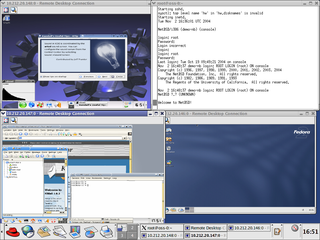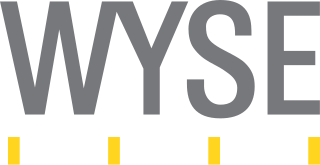Related Research Articles

In computer networking, a thin client, sometimes called slim client or lean client, is a simple (low-performance) computer that has been optimized for establishing a remote connection with a server-based computing environment. They are sometimes known as network computers, or in their simplest form as zero clients. The server does most of the work, which can include launching software programs, performing calculations, and storing data. This contrasts with a rich client or a conventional personal computer; the former is also intended for working in a client–server model but has significant local processing power, while the latter aims to perform its function mostly locally.

Citrix Systems, Inc. is an American multinational cloud computing and virtualization technology company that provides server, application and desktop virtualization, networking, software as a service (SaaS), and cloud computing technologies. Citrix claims that their products are used by over 400,000 clients worldwide, including 99% of the Fortune 100 and 98% of the Fortune 500.
Independent Computing Architecture (ICA) is a proprietary protocol for an application server system, designed by Citrix Systems. The protocol lays down a specification for passing data between servers and clients, but is not bound to any one platform. Citrix's ICA is an alternative to Microsoft's Remote Desktop Protocol (RDP).

Xen is a free and open-source type-1 hypervisor, providing services that allow multiple computer operating systems to execute on the same computer hardware concurrently. It was originally developed by the University of Cambridge Computer Laboratory and is now being developed by the Linux Foundation with support from Intel, Citrix, Arm Ltd, Huawei, AWS, Alibaba Cloud, AMD, Bitdefender and epam.
Application virtualization is a software technology that encapsulates computer programs from the underlying operating system on which they are executed. A fully virtualized application is not installed in the traditional sense, although it is still executed as if it were. The application behaves at runtime like it is directly interfacing with the original operating system and all the resources managed by it, but can be isolated or sandboxed to varying degrees.
Desktop virtualization is a software technology that separates the desktop environment and associated application software from the physical client device that is used to access it.
Microsoft Application Virtualization is an application virtualization and application streaming solution from Microsoft. It was originally developed by Softricity, a company based in Boston, Massachusetts, acquired by Microsoft on July 17, 2006. App-V represents Microsoft's entry to the application virtualization market, alongside their other virtualization technologies such as Hyper-V, Microsoft User Environment Virtualization (UE-V), Remote Desktop Services, and System Center Virtual Machine Manager.
Ericom Software, Inc. is a Closter, New Jersey-based company that provides web isolation and remote application access software to businesses.
Remote Desktop Services (RDS), known as Terminal Services in Windows Server 2008 and earlier, is one of the components of Microsoft Windows that allow a user to initiate and control an interactive session on a remote computer or virtual machine over a network connection. RDS was first released in 1998 as Terminal Server in Windows NT 4.0 Terminal Server Edition, a stand-alone edition of Windows NT 4.0 Server that allowed users to log in remotely. Starting with Windows 2000, it was integrated under the name of Terminal Services as an optional component in the server editions of the Windows NT family of operating systems, receiving updates and improvements with each version of Windows. Terminal Services were then renamed to Remote Desktop Services with Windows Server 2008 R2 in 2009.
InstallFree Inc. is a privately held company, backed by Ignition Partners and Trilogy Equity Partners, with headquarters in Stamford, CT and offices located worldwide. It was acquired by WatchDox. in December 2012. InstallFree specializes in Application Virtualization and delivery, based on their proprietary application virtualization technology that works on a variety of Microsoft Windows platforms such as Windows XP, Windows Vista, Windows 7, Windows Server 2003, Windows Server 2008, Terminal Server and Citrix XenApp.
A hosted desktop is a product set within the larger cloud-computing sphere generally delivered using a combination of technologies including hardware virtualization and some form of remote connection software, Citrix XenApp or Microsoft Remote Desktop Services being two of the most common. Processing takes place within the provider's datacenter environment with traffic between the datacenter and the client being primarily display updates, mouse movements and keyboard activity.

Wyse Technology, Inc., or simply Wyse, was an independent American manufacturer of cloud computing systems. Wyse are best remembered for their video terminal line introduced in the 1980s, which competed with the market-leading Digital. They also had a successful line of IBM PC compatible workstations in the mid-to-late 1980s. But starting late in the decade, Wyse were outcompeted by companies such as eventual parent Dell. Current products include thin client hardware and software as well as desktop virtualization solutions. Other products include cloud software-supporting desktop computers, laptops, and mobile devices. Dell Cloud Client Computing is partnered with IT vendors such as Citrix, IBM, Microsoft, and VMware.

2X Software was a Maltese software company specializing in virtual desktop, application virtualization, application delivery, Remote Desktop Services, remote access and Mobile Device Management. On 25 February 2015, 2X Software was acquired by Parallels, Inc. The 2X products, Remote Application Server and Mobile Device Management, are now included in Parallels' offering.
Citrix Workspace is a digital workspace software platform developed by Citrix Systems. Launched in 2018, it is Citrix Systems' flagship product. Citrix Workspace is an information retrieval service where users can access programs and files from a variety of sources through a central application or a Web browser. In addition to Citrix Virtual Apps and Desktops, Citrix Workspace services include Citrix Endpoint Management, Citrix Content Collaboration, Citrix Access Control, microapp capabilities, usage analytics, and single sign-on capabilities to SaaS and Web apps.
Citrix Cloud is a cloud management platform that allows organizations to deploy cloud-hosted desktops and apps to end users. It was developed by Citrix Systems and released in 2015.
NetScaler is a line of networking products owned by Cloud Software Group. The products consist of NetScaler, an application delivery controller (ADC), NetScaler AppFirewall, an application firewall, NetScaler Unified Gateway, NetScaler Application Delivery Management (ADM), and NetScaler SD-WAN, which provides software-defined wide-area networking management. NetScaler was initially developed in 1997 by Michel K Susai and acquired by Citrix Systems in 2005. Citrix consolidated all of its networking products under the NetScaler brand in 2016. On September 30, 2022, when Citrix was taken private as part of the merger with TIBCO Software, NetScaler was formed as a business unit under the Cloud Software Group.
Parallels RAS is application virtualization software produced by Parallels that allows Windows applications to be accessed via individual devices from a shared server or cloud system. Parallels RAS was first released in 2014 by 2X Software.
Ericom Connect is a remote access/application publishing solution produced by Ericom Software that provides secure, centrally managed access to physical or hosted desktops and applications running on Microsoft Windows and Linux systems.
Citrix Virtual Desktops is a desktop virtualization product.
References
- 1 2 Joe Brodkin (25 August 2008). "Citrix puts virtualization spin on flagship application delivery software". Network World . Retrieved 5 November 2015.
- 1 2 3 4 5 6 Greg Shields (4 April 2014). "Citrix Products Evolve, but Name Changes Obscure Unification". Redmond magazine. Retrieved 5 November 2015.
- 1 2 3 4 5 Alyssa Wood (27 January 2014). "XenApp 7.5 dodges desktops with app delivery to mobile devices, cloud". TechTarget . Archived from the original on 20 August 2015. Retrieved 5 November 2015.
- 1 2 Larry Dignan (28 January 2014). "Citrix latest XenDesktop, XenApp plug into Amazon Web Services, CloudStack". ZDNet . Retrieved 4 November 2015.
- 1 2 Joe Brodkin (12 August 2011). "Google Chromebooks now run Windows through Citrix Receiver". Network World . Retrieved 5 November 2015.
- 1 2 Jack Madden (November 2011). "Citrix XenApp definition". TechTarget . Retrieved 5 November 2015.
- 1 2 Frank Ohlhorst (8 November 2012). "Citrix XenApp 6.5: Eight exciting enhancements". TechTarget . Archived from the original on 5 September 2015. Retrieved 5 November 2015.
- 1 2 Paul Stansel (19 October 2005). "Citrix Access Suite 4.0 – It's Not Your Daddy's MetaFrame". VirtualizationAdmin.com. Archived from the original on 2 April 2015. Retrieved 4 November 2015.
- ↑ Mikael Ricknäs (10 March 2010). "XenApp 6 centralizes management, adds Android and Mac support". InfoWorld . Retrieved 5 November 2015.
- ↑ Foley, Mary Jo. "More details emerge on Citrix's plans for Microsoft's Windows Virtual Desktop". ZDNet. Retrieved 19 June 2019.
- ↑ "Comparing the features of Citrix and VMware's VDI software". TechTarget. Retrieved 6 March 2023.